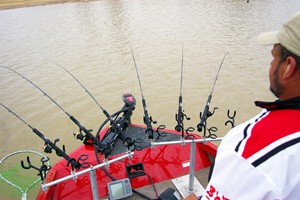| In the old days, crappie fishing was often done with cane poles, or spin cast gear with slip bobbers and minnows. Well, as fishing tackle and technology improved, so have the methods to catch more crappies. The technique called “spider-rigging” has taken crappie fishing to a whole new level and is more effective year round for these fish than any other tactic in my opinion.
Spider-rigging (slow vertical trolling) for crappie is becoming more and more popular among tournament pros and weekend anglers. Many tournaments have been won by using this technique, and spider-rigging has proven to be the most productive method for putting good numbers of crappie into live wells. The term “spider-rigging” comes from the way the boat is rigged, with poles sticking out from all sides of the boat looking like a spider. This set-up allows the anglers to cover a lot of water at various depths and quickly search for potential crappie hangouts and finding schools of crappie. Once the fish is found, this deadly technique allows the anglers to present the baits thoroughly around drop offs, brush piles, and other similar cover.
Spider rigging may involve the use of as few as two poles or as many as 16, but six to eight are most commonly used. The poles, long, graphite or graphite-composite trolling or jigging poles, or sometimes cane poles are held in rod holders. In more recent years, however, manufacturers have begun offering high-quality T-bar holders that won’t slip off or twist to the side like the old C-clamps. These have two to eight rod holders attached to a crossbar, and each crossbar is on an upright that has a bottom bracket for securing the T-bar in the boat. When properly placed, these T-bar holders allow the angler to fish with several poles spread out at regular intervals across the front, back and/or sides of the boat, usually a foot or two apart. Rigged this way, the angler can drift with the wind or troll with a trolling motor and sweep a broad area of water with a variety of baits to find crappie.
 |
There are many different rigs you can use on your spider-rig poles. One of the simplest is made by attaching a 1-ounce bank sinker to the end of your main line. Above this are two to four 12- to 18-inch-long drop lines (shorter lines on top, longer on bottom) spaced about 18 inches apart. Each drop line is connected to the main line via a loop knot or swivel. Jigs or 1/0 to 2/0 Aberdeen style crappie hooks are tied to the drop lines. If hooks are used, they are baited with live minnows. If you like, you can tip jigs with minnows as well, for extra enticement. The finished rigs are lowered close to the bottom prior to trolling. When landing a fish while spider rigging, there are two things that you must remember.
First, the biggest mistake people make when hooking a fish, is dropping the rod tip while taking the rod out of the rod holder. If you drop the tip of the pole, 9 times out of 10 the fish will get off. Once you set the hook, hold pressure on the rod until you can get your hand on the reel. Stand up if you have to, but don’t drop the rod tip.
The second biggest mistake people make while spider rigging with long poles is reeling up too much line while trying to land a fish. If you reel all the line in, there is no way to grab the fish at the end of a long pole. You must leave enough line in the water so you can swing the fish into the boat. It is best to use a dip net on the larger fish to keep from breaking the line while trying to bring them in the boat.
Experiment with this very effective technique and start out with a small number of rods at first until your comfort level grows and your confidence builds, and soon you will be catching more crappies consistently than ever before.
Tom Dietz is a professional fishing guide and avid musky tournament angler originally from Wisconsin. He has been involved in the fishing tackle industry for over 18 years working for Joe Bucher Tackle and TV show, Mepps, Mister Twister Lures and currently a store manager at Gander Mountain. Tom writes articles for Musky Hunter Magazine, Muskies, Inc. Magazine, and Ohio Outdoor News each year and also provides informative seminars at sport shows, retail locations, and club meetings throughout the Upper Midwest in Chicago, Pittsburgh, Cincinnati, Dayton and Columbus, Ohio. For more information about Tom please visit his website at TomDietz.Com |